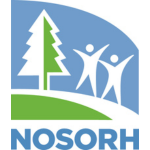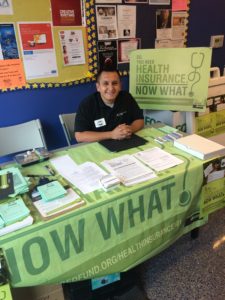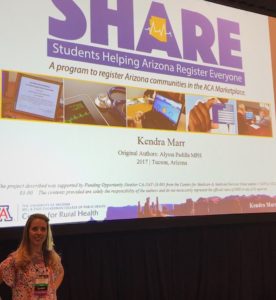by Beth Blevins
People in Arizona communities are becoming more aware of their health insurance options through Project SHARE (Students Helping Arizona Register Everyone).
Project SHARE, run by the Arizona Center for Rural Health (AzCRH), trains University of Arizona health sciences students as Certified Application Counselors (CACs) that provide information on enrollment through the Affordable Care Act (ACA) marketplace. Alyssa Padilla, who supervises the SHARE program for the Arizona State Office of Rural Health (AzSORH) under the AzCRH, said that the program helps not just the patients but also the students, who become more rural and health insurance literate.
“SHARE gives the students a better understanding of social support services and how to connect individuals with those services,” Padilla said. Through SHARE, the students earn volunteer credits that allow them to graduate with distinction. But, more importantly, Padilla said, graduates of the program “are better equipped to answer patients’ questions about coverage on the spot.” To become a SHARE participant, students take five to 10 hours of online federal training in addition to in-person session training, Padilla said.
When surveyed afterwards, participants have said the program has given them a better understanding of the ACA, health insurance premiums and deductibles, and the value of expanding Medicaid in Arizona, Padilla said.
Lauren Dominick said she has already benefited from the program. Dominick, an MD candidate and Project SHARE leader for the UA-College of Medicine–Phoenix, joined last year hoping to develop the skills that will help her better serve current and future patients. “I have gained so much knowledge of how the marketplace works and how to navigate it,” Dominick said. “I’ve helped patients complete their ACA applications and seen the empowerment they experience as they take better control of their health care. The program opens up their opportunities to seek preventative health care rather than just when they have an acute, major issue.”
Unfortunately, Dominick said, as a medical student she has seen many patients with very advanced diseases who were unable to access care earlier. “This is heartbreaking, especially when their condition could have been prevented or effectively managed if they had had access to health care.” Dominick added, “Helping sign people up for insurance makes me feel like I am making a difference and hopefully having a positive impact on their health even before I see them in the clinic or the hospital.”
Kendra Marr, an MD/PhD student at the UA College of Medicine-Tucson and Tucson SHARE leader, said that another benefit she has found with SHARE is the “wealth of opportunities for collaboration with other clubs and services within the College of Medicine,” including the Commitment to Underserved People (CUP) health clinics. Marr has been working with the free, student-run CUP clinics to form a partnership so that SHARE can refer patients to them and vice versa, and has been holding her SHARE enrollment office hours at the clinics.
Project SHARE has benefited the university as well. “The University of Arizona is a White House Healthy Campus because of Project SHARE and UA Campus Health’s efforts to improve access to health insurance coverage,” Padilla said.
Right now, Project SHARE offers in-person, outreach, education, and one-on-one enrollment services in Pima County and in-person outreach services in Maricopa County, Padilla said. The CACs also can volunteer to staff the Cover Arizona phone number, where they answer insurance questions and schedule appointments for patients across the state.
Typically, 15 to 25 students work for SHARE each year, Padilla said. So far, 90 students from the UA Colleges of Medicine, Nursing, Public Health, and Pharmacy have gone through the SHARE program since its inception in 2015.
In her role with the AzSORH, Padilla oversees the licensing, recruitment, training, and mentoring of the SHARE participants. Most of the funding for the program comes from SORH grants, Padilla said, with small additional amounts of funding from UA College of Medicine CUP, which pays for things like food for the students during their trainings.
Padilla said she hopes other SORHs will consider replicating Project SHARE. The AzSORH has created templates on the processes involved and how-to directions, which Padilla will provide to any interested SORHs. Meanwhile, Padilla said that AzCRH is planning to extend the reach of SHARE to remote areas of her state through partnerships with Critical Access Hospitals and rural faith-based communities.
Since the ACA has been in effect, Padilla said, the uninsured rate in Arizona has been cut in half (to 10 to 11 percent), similar to the national average. “It’s important to note that we have a conservative Republican governor, and we have expanded Medicaid,” she said. “Our hospitals are no longer in the red because we have patients that are now insured due to Medicaid expansion and the ACA.”
“Medicaid expansion has really helped our bottom line,” Padilla concluded. “State Offices of Rural Health support that effort and that message ‑ it can do wonders for our rural and underserved communities.”
————————————————————————————
Does your SORH have a “Promising Practice”? We’re interested in the innovative, effective and valuable work that SORHs are doing. Contact Ashley Muninger to set up a short email or phone interview in which you can tell your story.


